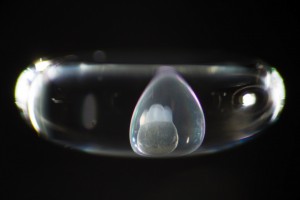Fly like a fish?
Posted by Maria Sundvik, on 26 October 2015
Zebrafish is a common model organism in many fields of science. The study by Sundvik et al. 2015 in Scientific Reports tests the safety of acoustic levitation of an intact organism using zebrafish embryos (Figure 1). Acoustic levitation has over the last few decades been developed to provide a wall- and contactless environment to transfer and manipulate small objects, more recently cells and even entire organisms. This method has great potential that could be useful also outside physics labs. A zebrafish in a levitator encounters sound levels comparable to those next to a screaming jet engine, but the sound is still inaudible to humans. From a developmental point of view it is interesting to note that the developing zebrafish are insensitive to the harsh conditions in the levitator. The fish develops normally in the apparently gravitation-free space, in the node of the sound waves, when sonified for a short time between one and 12 hours after fertilization. It is unknown whether levitation at even later time points after fertilization affects the fish development. We found that fish do die if the water surrounding the embryo evaporates. A controllable microclimate around the levitator could permit investigating whether longer levitation periods affect the development and patterning of tissues and organs in the levitated fish. Such a setup would permit levitating the zebrafish for days, potentially without liquid immersion for some developmental stages. This study is a beginning and only imagination restricts the possibilities of this approach.
Figure 1. A levitating zebrafish embryo inside an ellipsoidal water droplet. Photography: Mr Eetu Lampsijärvi



 (2 votes)
(2 votes)